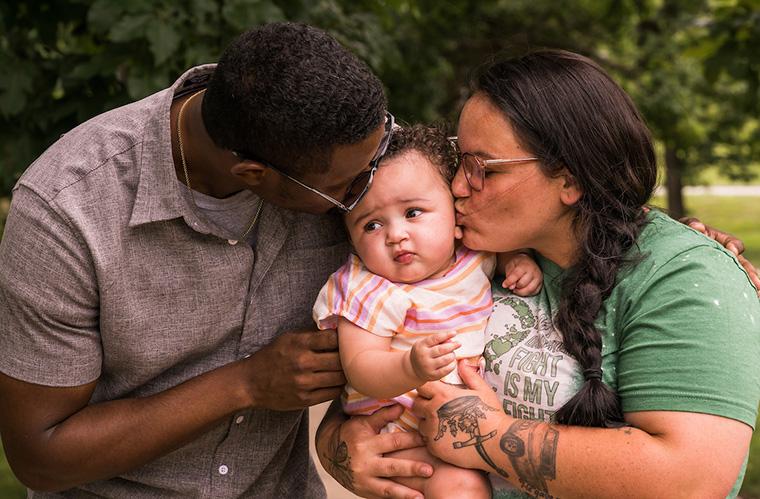The first thing most people notice about Nola Brown is her smile.
Nola's parents, Mylissa and Shelton Brown, welcomed her into the world at Women’s Hospital in Columbia on July 11, 2022, and were quickly treated to a beaming grin that seemed to never turn off. Especially when she spends time outside or plays with (and aggravates) her older siblings.
But behind that smile, something wasn’t right. Something that didn’t show up during Mylissa’s ultrasounds, checkups or those first 30 days after delivery.
“I think most people see her as a genuinely happy baby,” Mylissa said. “But looking back you can tell she was probably really uncomfortable, and we had no idea.”
At a checkup on Sept. 12, 2022, the Browns and pediatrician Elizabeth Sheppard, MD, noticed Nola’s skin looked a little yellow. Sheppard ordered some blood tests, and the results showed Nola had too much bilirubin, a yellow compound found in bile, in her blood.
Sheppard called the Browns that evening and asked them to return from Jefferson City to Children’s Hospital for more testing. At that point, Nola’s jaundice had yellowed the whites of her eyes.
After some nervous waiting, Mylissa and Shelton spoke with pediatric surgeon Rony Marwan, MD, who had an answer for what their daughter was experiencing.
Nola was born with a rare and serious liver condition called biliary atresia. Her body could not send bile, which is produced in the liver and stored in the gall bladder, to her intestine. If untreated, the condition leads to liver failure. Nola struggled to gain weight because bile helps digest fat and absorb vitamins A, D, E and K, all of which are essential for early childhood development.
But there was good news in Marwan’s message: They had caught it early. The best chance to successfully treat biliary atresia is to perform a surgical procedure — aimed at reducing bilirubin levels to less than 2mg/dL — within the first two to three months.
Working closely with Venkataraman Ramachandran, MD, another pediatric surgeon at MU Health Care, Marwan told the Browns a surgery called a Kasai procedure might be the solution.
“In a baby with biliary atresia, the bile does not flow from the liver to the intestine, which ends with liver failure,” Marwan said. “With a Kasai procedure, we create a new path for bile to flow to the intestine so that it does its job. But more importantly it prevents liver damage and greatly decreases the chance babies like Nola need a liver transplantation.”
Because they have received special surgical training and successfully performed Kasai procedures before, Ramachandran and Marwan are able to give families in Missouri the peace of mind that world-class care is available close to home.
“I have been a pediatric surgeon at MU Health Care for 22 years,” Ramachandran said. “I have treated babies here who like Nola had very complex cases and have gone on to school and called me after graduating to tell me how they are doing. It’s so satisfying to see that they can live normal lives after what would have been a very disastrous thing many decades ago, and that’s what we want for Nola.”
Nola was admitted to Children’s Hospital on a Monday and was ready for her surgery on Friday. Marwan, Ramachandran and the rest of the care team, including nurses, operating room staff, radiologists and technicians, and anesthesiologists, had to work with precision and care on Nola, who weighed nine pounds at the time of her surgery.
Mylissa wore a hole in her Crocs pacing in the waiting room before Nola’s doctors reunited her with her parents.
“When I saw her face after, and the scar, it all hit me at once,” Shelton said. “I called my dad from the bathroom, and held it together for a little bit, and then I let go. The water works started when I told him she was OK, and we cried and prayed together.”
Nola’s surgery was a success, but she needed some extra care to get back on track. At eight months old, she still wasn’t eating as much as she needed, and weighed as much as an average one-month-old. She also missed out on tummy time because the scar on her stomach was healing.
As Nola approaches her first birthday, physical therapy is helping her gain strength in her neck. But the breakthrough to get Nola eating came a different way: a formula change, and sweets from a takeout place, courtesy of her brother Arthur.
“That was the first thing she ate on her own,” Mylissa said. “Shelton called me and said, ‘Arthur gave her a Chinese donut when I wasn’t looking, and she’s tearing it up.’ She started eating after that, and with the formula change she’s now in the 24th percentile for her weight. It’s great to see that.”
Ramachandran and Marwan look forward to Nola’s smile when they see her for follow-up clinic visits and are happy to see her continue to make progress. Though the Browns are moving near St. Louis to be closer to family, they plan to continue seeing Nola’s surgeons for her follow-up care.
“Dr. Marwan and Dr. Ram were a godsend,” Mylissa said. “They made us feel like family, and they got attached to Nola, too. I won’t take her anywhere else.”






